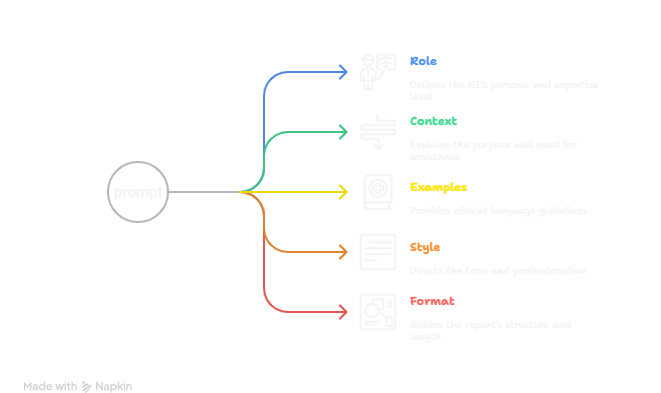Prompt Engineering for Medical Professionals: A Practical Guide
Many doctors including me are using ChatGPT to save time and effort in completing medical or research related tasks, such as writing reports , creating PPTs ,writing dissertation and writing their manuscripts. But they often miss out on prompt engineering. Prompt engineering is an important skill which will save you hours of your time and tweaking to get the right output from ChatGPT everytime.
This guide walks doctors, radiologists, and other healthcare professionals through crafting better prompts to get accurate, clinically relevant, and context-specific responses from AI systems like ChatGPT. The best prompts can be broken down into the following key components: Role, Context, Examples, Style, and Format.

What is Prompt Engineering?
Prompt engineering is the skill of giving precise, structured instructions to a language model to get the best possible response. It’s especially important in healthcare, where clarity and accuracy are paramount.
The goal: Speak to the AI in a way that’s clear, context-rich, and goal-oriented.
Let’s Apply This: A Radiologist’s Use Case
Imagine you’re a radiologist who just finished reviewing a CT scan of the abdomen. You want to use ChatGPT to generate a structured, professional report draft based on your observations. Here’s how you could apply the prompt engineering formula:
1. Role
“You are a senior radiologist experienced in abdominal imaging.”
This tells the AI what role to assume and the level of expertise it should reflect.
2. Context
“I have reviewed a contrast-enhanced CT abdomen of a 55-year-old male with right lower quadrant pain. I need help drafting a structured radiology report.”
Explain why you’re asking and what the AI should help with.
3. Examples
“Use common terminology like ‘no evidence of free air’ or ‘mild fat stranding in the right iliac fossa’.”
This gives the AI a clear sense of the expected clinical language.
4. Style
“Maintain a formal, concise, and objective tone, suitable for EHR documentation.”
Direct the tone and professionalism of the response.
5. Format
“Structure the report with headers: Indication, Technique, Findings, and Impression. Limit to 200 words.”
Guide the layout and structure of the output.
Final Prompt
Prompt:
You are a senior radiologist experienced in abdominal imaging. I have reviewed a contrast-enhanced CT abdomen of a 55-year-old male with right lower quadrant pain. I need help drafting a structured radiology report. Please structure it with the following sections: Indication, Technique, Findings, and Impression. Use a formal and concise tone suitable for clinical documentation. Limit the report to 200 words. Use phrases like ‘no evidence of’ and ‘suggestive of’ where appropriate.
The LLM output based on your prompt:
Indication:
55-year-old male with right lower quadrant pain.Technique:
Contrast-enhanced CT scan of the abdomen and pelvis was performed.Findings:
No evidence of free intraperitoneal air or fluid. The appendix is mildly enlarged (8 mm in diameter) with surrounding fat stranding in the right iliac fossa, suggestive of acute appendicitis. No appendicolith identified. No bowel obstruction or perforation. Liver, spleen, pancreas, kidneys, and bladder are unremarkable.Impression:
Findings consistent with acute appendicitis. Recommend surgical evaluation.
You can provide additional information such as word limits, style and your own findings till you are comfortable with a specific style of the final report
Why This Matters for Doctors
Prompt engineering helps:
- Save time on documentation.
- Improve report structure and consistency.
- Serve as a second-opinion or template assistant.
- Enhance interdisciplinary communication.
Summary
Incorporating AI tools into your medical workflow doesn’t require coding—just good prompt engineering. Whether you’re a radiologist drafting reports or a physician summarizing discharge instructions, structuring your prompt using the Role + Context + Examples + Style + Format formula ensures more useful outputs, faster.
If you want a compilation of prompts for medical professionals, please comment your email id, we will share a list of ready to use prompts for you
Pro tip: Save your best prompts as templates for future use. AI doesn’t replace your expertise—it scales it.
